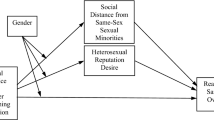Abstract
This work focuses on the variations in societal responses perceived by male homosexuals in different group settings of interaction and on the relationship of these responses to their social status and related behavioral characteristics. Based on the analysis of data collected from a sampling of 148 male homosexuals in and around a large midwestern city, it is concluded that (1) stereotypic responses are more likely to occur under the interactional prescripts characteristic of secondary groups due to the impersonal and almost “one-way” interaction which characterizes them and (2) lower-class homosexuals are more likely to perceive stereotypic responses because of their closer approximation to the stereotypic image of the homosexual. It is also suggested that exhibiting behavior which closely approximates the stereotype may be a manifestation of the lowerclass homosexual's desire to be clearly identified with the homosexual community and to conform to the sex role stereotypic expectations of the lower classes. Such behavior may provide for a meaningful self-definition and opportunity for upward mobility unattainable in the larger society.
Similar content being viewed by others
References
Blalock, H. M. (1960).Social Statistics McGraw-Hill, New York.
Blumer, H. (1966). Sociological implications of the thought of George Herbert Mead.Am. J. Sociol. 71: 535–544.
Blumer, H. (1969).Symbolic Interactionism: Perspective and Method Prentice-Hall, Englewood Cliffs, N.J.
Bonjean, C. M., Hill, R., and McLemore, S. (1967).Sociological Measurement Chandler, San Francisco.
Buckley, W. (1967).Sociology and Modern Systems Theory Prentice-Hall, Englewood Cliffs, N.J.
Cooley, C. H. (1902).Human Nature and the Social Order Scribner's, New York.
Cooley, C. H. (1909).Social Organization Scribner's, New York.
Cronbach, L. J. (1951). Coefficient alpha and the internal structure of tests.Psychometrika 16: 297–334.
Dohrenwend, B. P., and Chin-Shong, E. (1967). Social status and attitudes toward psychological disorder: The problem of tolerance of deviance.Am. Sociol. Rev. 32: 417–433.
Duggan, T., and Dean, C. (1968). Common misinterpretations of significance levels in sociological journals.Am. Sociologist 3: 45–46.
Farrell, R. A. (1971). Class linkages of legal treatment of homosexuals.Criminology 9: 49–68.
Gallo, J. J.,et al. (1965–1966). The consenting adult homosexual and the law.UCLA Law Rev. 13: 686–742.
Glaser, B. G., and Strauss, A. (1964). Awareness contexts and social interaction.Am. Sociol. Rev. 29: 669–679.
Goffman, E. (1963).Stigma: Notes on the Management of Spoiled Identity Prentice-Hall, Englewood Cliffs, N.J.
Gold, D. (1969). Statistical tests and substantive significance.Am. Sociologist 4: 42–46.
Hacker, H. M. (1971). Homosexuals: Deviant or minority group? In Sagarin, E. (ed.),The Other Minorities Ginn, Waltham, Mass., pp. 65–92.
Homans, G. (1950).The Human Group Harcourt, Brace, New York.
Humphreys, L. (1970).Tearoom Trade: Impersonal Sex in Public Places Aldine, Chicago.
Kitsuse, J. (1962). Societal reaction to deviant behavior: Problems of theory and method.Soc. Problems 9: 247–256.
Leznoff, M., and Westley, W. (1965). The homosexual community.Soc. Problems 3: 257–263.
Mechanic, D. (1962). Some factors in identifying and defining mental illness.Ment. Hyg. 46: 66–74.
Morrione, T. J. (1971). The omission of the “i”: A clue to understanding the link between social action theory and symbolic interactionism. Paper presented at the 1971 Annual Meeting of the Pacific Sociological Society.
Myerhoff, H. L., and Myerhoff, B. G. (1964). Field observation of middle class gangs.Soc. Forces 42: 328–336.
Rubington, E., and Weinberg, M. S. (1968). The social deviant. Part I inDeviance: The Interactionist Perspective, Macmillan, New York.
Simon, W., and Gagnon, J. (1969). Homosexuality: The formulation of a sociological perspective. In Weltge, R. W. (ed.),The Same Sex Pilgrim Press, Philadelphia. Originally printed inJ. Health Soc. Behav. 8(3), 1967.
Strerfert, S. (1965). Communicator importance and interpersonal attitudes toward conforming and deviant group members.J. Personal. Soc. Psychol. 2: 242–246.
Terry, R. M. (1967). The screening of juvenile offenders.J. Crim. Law Criminol. Pol. Sci. 58: 173–181.
Thomas, W. I. (1923).The Unadjusted Girl Little, Brown, Boston.
Turner, R. (1962). Role-taking: Process versus conformity. In Rose, A.M. (ed.),Human Behavior and Social Process: An Interactionist Approach Houghton Mifflin, Boston.
Weinberg, M. S. (1970). Homosexual samples: Differences and similarities.J. Sex Res. 6: 312–325.
Williams, C. J., and Weinberg, M. S. (1971).Homosexuals and the Military Harper and Row, New York.
Wilson, T. P. (1970). Conceptions of interaction and forms of sociological explanation.Am. Sociol. Rev. 35: 697–710.
Winch, R., and Campbell, D. (1969). Proof? No. Evidence? Yes. The significance of tests of significance.Am. Sociologist 4:140–143
Author information
Authors and Affiliations
Rights and permissions
About this article
Cite this article
Farrell, R.A., Morrione, T.J. Social interaction and stereotypic responses to homosexuals. Arch Sex Behav 3, 425–442 (1974). https://doi.org/10.1007/BF01541163
Issue Date:
DOI: https://doi.org/10.1007/BF01541163




